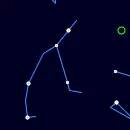Barbell Nebula (M76) Observation Details

M76 Daily Motion
M76 is circumpolar, never setting below the horizon and always visible in the night sky from your location. However, it will change its position significantly, moving 77 degrees over time. You can find the best times to observe M76, when it reaches its highest elevation, in the annual motion section.M76 will become visible in May, 25. After being too close to the Sun to observe, it will reappear in the night sky. Starting from May, 25, M76 can be seen again, providing a good opportunity for observation.
M76 Visibility Timetable on April 26
M76 Rise and Set Timetable
| Time | Elevation | |
| M76 is always above the horizon | ||
| Moon Rise, 8.7% illuminated | 05:18 | 17° |
| M76 transit | 12:58 | 78° |
| Moon Set | 18:02 | 38° |
| Sunset | 20:19 | 20° |
| Civil sunset | 20:49 | 16° |
| Astrosession begin | 22:02 | 9° |
| M76 is always above the horizon | ||
| Astrosession end | 04:57 | 15° |
| Civil sunrise | 06:09 | 24° |
| Sunrise | 06:39 | 28° |
Track M76 Position Throughout the Night
← Sat, 26 April 2025 →
| Time | |
| Altitude | |
| Azimuth |
M76 - Little Dumbbell Nebula
The Little Dumbbell Nebula (M76) is a planetary nebula located in the constellation Perseus. It was discovered by Pierre Méchain in 1780 and later cataloged by Charles Messier. M76 is one of the fainter objects in the Messier catalog.
M76 spans about 1.23 light-years across and contains a central white dwarf star surrounded by a shell of ionized gas. The nebula is approximately 2,500 light-years away from Earth and has an apparent magnitude of 10.1, making it visible with a small telescope.
Finder Chart for M76
| Object name | M76 |
| Field of view | |
| Limiting magnitude | |
| M76 coordinates | 1.70547, 51.57547 |
| Center coordinates | 1.70547, 51.57547 |
M76 Passage Through Night
Current position of M76
| Time | 23:08 |
| Latitude | 39.9625 |
| Longitude | -83.0061 |
| M76 elevation | 5° |
| M76 Azimuth | 17° |
Annual motion of M76
| Date | Sun, 27 April 2025 |
| Twighlight start | 22:03 |
| Twighlight end | 04:54 |
| Twighlight duration | 7h 51m |
| Rise | M76 is always up |
| Set | M76 is always up |
| Elevation at transit | 78° |
| Transit time | 12:54 |
| Equatorial coordinates | RA: 01h 42m 19s", Dec: 51° 34' 31s |
| Magnitude | 10 |
| Constellation | Perseus |
The graph is structured with the vertical axis showing the hours of the day, ranging from 12 AM to 12 AM the next day, while the horizontal axis spans each day of the year.
The reddish shaded area indicates the periods when the M76 is above the horizon, visible to observers. The white line marks the times when the celestial object reaches its highest point in the sky each day, known as the transit.
Data Credits
The nebulae information on this page is sourced from the OpenNGC project, developed by Matteo Verga. OpenNGC provides detailed data on the NGC catalog, which is a valuable resource for exploring deep-sky objects such as nebulae.
For more details or to contribute to OpenNGC, visit the official GitHub repository: OpenNGC on GitHub.
